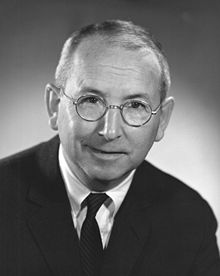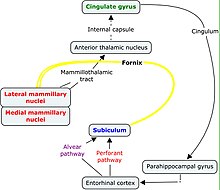User:Dpatel90/sandbox
| This user page or section is in a state of significant expansion or restructuring. You are welcome to assist in its construction by editing it as well. If this user page has not been edited in several days, please remove this template. If you are the editor who added this template and you are actively editing, please be sure to replace this template with {{in use}} during the active editing session. Click on the link for template parameters to use.
This page was last edited by Jonesey95 (talk | contribs) 6 months ago. (Update timer) |

The Papez circuit is a neural pathway in the brain founded by American neuroanatomist James Papez in 1937. It was thought to be responsible for emotions but recent studies show that it has a role in memory functions as well. The Papez circuit was later modified by American neuroscientist and physician Paul D. MacLean and now, the circuit is known as the limbic system.
History[edit]

In 1907/1908, Bavarian neuropathologist Christfried Jakob discovered the visercal brain. By date, he held the "... first interpretation of the limbic or ‘internal’ brain as a viscero-emotional mechanism..." He traced the structures of the system based on degeneration experiments in apes and dogs as well as neurodegenerative diseases in humans.[1]
However, it was not until 1937 when James Papez studied this system in detail that it became famous. Papez had been studying cases of rabies which is a disease that causes high levels of aggression. He noticed that this heightened aggression correlated with damage to the hippocampus. [2] Theoretically, this made sense to Papez who asserted that the hippocampus is responsible for the expression of emotion because of its connection to the autonomic nervous system. He also noticed that in other cases, certain stimuli (taste, smell, pain, etc.) would cause strong emotional responses. These stimuli activated not only the hippocampus but also other brain structures. He theorized that these brain structures worked together as the emotional control center in the brain and consequently founded the Papez circuit.[3] Because of these studies, Papez strongly believed that the circuit was the cortical control of emotion.
Around the same time, Paul D. MacLean was also interested in the Papez circuit. He had read through Paul Broca's research which indicated that the limbic lobe that surrounds the brainstem is a structure present in all mammals. Papez's paper on the emotional circuit which involved the connection between the hypothalamus and the limbic lobe set MacLean on a journey to learn more. He visited Papez at Cornell University after which he proposed a modified version of the Papez circuit in 1952, emphasizing not only the hippocampus, but also the amygdala and septum.[4]
The hippocampus, amygdala, and septum make up the rhinencephalon (frontotemporal portion of the brain) or, as Jakob termed it, the visceral brain. Together, the limbic lobe and the visceral brain make up the limbic system. MacLean believed that including the visceral brain in the limbic system accounted for the external sensory information associated with subjective emotional experiences. Since the limbic system consists of evolutionary primitive structures which prevents its interpretation verbally, the visceral brain accounts for the visual, auditory, olfactory, and other external sensory inputs that are associated with emotions.[4]
Recently, many studies have been done to analyze the anatomy and function of the Papez circuit. Many scientists have been finding proof that the circuit is related to memory as well as emotion. The limbic system, the modified version of the circuit proposed by MacLean, is thought to be involved in the same functions as well as behavior, motivation, and olfaction.[5]
Anatomy[edit]

The Papez circuit involves various structures of the brain. It begins and ends with the hippocampus (or the hippocampal formation). Fiber dissection indicates that the average size of the circuit is 350 milimeters. The Papez circuit goes through the following neural pathway:
hippocampal formation (subiculum) → fornix → mammillary bodies → mammillothalamic tract → anterior thalamic nucleus → cingulum → entorhinal cortex → hippocampal formation.[6]
A photograph of the inferior medial view of the brain when dissected clearly shows the layout of the Papez circuit. Due to the location of the structures in the circuit, the resulting shape is a limbus. This is what drove MacLean to call the circuit the limbic system when he later modified the circuit.
Various studies indicate that the Papez circuit is greatly influenced by the cerebellum and that perhaps the hippocampus is not the starting point of the circuit. Anatomically, this would make sense since the cerebellum is connected to the circuit with many fine fibers and fiber bundles. Chemical lesions on the cerebellum seem to have an inhibitory effect on the circuit. Animal behavioral studies show that electrical stimulation of the anterior cerebellum can cause arousal, predatory attack, and feeding responses, all of which are thought to be expressions of emotion. Overall, these studies provide evidence that the cerebellum may also be included in an emotional system of the brain.[7]
Functions[edit]
Emotion[edit]

Based on Papez's experiment with aggression in rats and other studies, it was initially believed that the circuit was involved with emotion. The circuit connects the hypothalamus and the cortex and acts as the emotional system of the brain. "The cingulate cortex projects to the hippocampus, and the hippocampus projects to the hypothalamus by way of the bundle of axons called the fornix. Hypothalamic effects reach the cortex via a relay in the anterior thalamic nuclei."[8]
However, there has not been additional proof of the circuit's role in emotion over the years. Now, the amygdala is thought to play a key role in emotion, a structure that was not a part of the Papez circuit until 1952 when MacLean included it in the modified version of the circuit, the limbic system.
Memory[edit]
In the past few years, many experiments have been done that involve structures of the Papez circuit. Moreover, many cases where structures of the Papez circuit have been damaged show changes that indicate its real function.
One study shows that the Papez circuit plays a crucial role in memory. An experiment was conducted on 35 male Sprague-Dawley rats that were first anesthetized. Bipolar, reference, and ground screw electrodes were used to measure hippocampal EEG (theta rhythm) and were placed over the frontal and occipital regions of the cortex. The stimulus was a pinch to the tails of the rats which caused a change in the theta waves. About 75% of the anterior ventral thalamus neurons fired rhythmically with the theta waves. About 46% of anterior ventral thalamus cells fired with strong rhythmic coherence (0.58 mean coherence value) while 29% of cells had a more moderate reaction (0.20 mean coherence value). Other cells showed no rhythmic synchronization. Neurons from the anterior dorsal and anterior medial regions in the thalamus showed no rhythmic synchronization either but did show a marked increase in firing rates. Therefore, the experiment seems to show that some of the first components of the Papez circuit have theta-rhythmic cells. This may indicate that these signals resonate throughout the entire circuit. Since theta signals are thought to be linked to learning and memory, it may consequently be that the Papez circuit is involved with memory.[9]
Another study specifies that the circuit plays a key role in spatial and episodic memory. Using similar methods as the previously mentioned study (theta rhythmicity) A coherence analysis of neuronal synchronization among three structures of the circuit indicate strong relationships between the structures. Moreover, since measuring theta waves is thought to measure neural information flow, the study further asserts the theory that the Papez circuit plays a strong role in memory.[10]
Associated Disorders[edit]
Alzheimer's Disease[edit]
Alzheimer's is a common neurodegenerative disease. It leaves patients impaired or unable to learn new information. When the hippocampus and other medical temporal lobe structures are damaged, the disease affects episodic memory. Not only do patients have difficulty coming up with the names of people but also the names of other types of objects.
Parkinson's Disease[edit]
Parkinson's is caused by the degeneration of the substantia nigra in the midbrain. There may also be damage to the structures of the Papez circuit in this disease. Usually, Parkinson's is correlated with depletion of dopamine in the basal ganglia.
Huntington's Disease[edit]
Huntington's is caused by the degeneration in caudate nucleus of striatum.
Semantic Dementia[edit]
Semantic dementia is a rare degenerative disorder that exhibits defects in all semantic memory functions, including naming, single word comprehension and impoverished general knowledge, with relative preservation of other components of speech, perceptual and nonverbal problem-solving skills, and episodic memory.
Karsakoff Syndrome[edit]
The Karsakoff Syndrome occurs when a chronic alcoholic patient suffers from poor nutrition and in particular develops thiamine deficiency. Damage to the mammillary bodies (loss of neurons and myelination) interrupts the Papez circuit. There is a profound loss of the ability to learn new information or to retrieve recently acquired memories.
Transient Global Amnesia[edit]
Transient global amnesia is a very rare disorder and not much is known about it. Patients acutely develop a selective disorder of episodic memory, losing from several to 48 hours of previously learned information and are unable to learn new information.
References[edit]
- ^ Triarhou, L. C. (2008). Centenary of Christfried Jakob's discovery of the visceral brain: An unheeded precedence in affective neuroscience. Neuroscience and Biobehavioral Reviews, 32(5), 984-1000. doi: 10.1016/j.neubiorev.2008.03.013
- ^ Eysenck, M. (2004). Psychology: An International Perspective: Taylor & Francis.
- ^ Klein, S. B., & Thorne, B. M. (2006). Biological Psychology: Worth Publishers.
- ^ a b Newman, J. D., & Harris, J. C. (2009). The Scientific Contributions of Paul D. MacLean (1913-2007). The Journal of Nervous and Mental Disease, 197(1).
- ^ Medline Plus Medical Encyclopedia
- ^ Shah, A., Jhawar, S. S., & Goel, A. (2012). Analysis of the anatomy of the Papez circuit and adjoining limbic system by fiber dissection techniques. [Article]. Journal of Clinical Neuroscience, 19(2), 289-298. doi: 10.1016/j.jocn.2011.04.039.
- ^ Snider, R. S., & Maiti, A. (1976). CEREBELLAR CONTRIBUTIONS TO PAPEZ CIRCUIT. Journal of Neuroscience Research, 2(2), 133-146. doi: 10.1002/jnr.490020204.
- ^ Bear, Mark F., Connors, Barry W., & Paradiso, Michael A. (2006). Neuroscience: Exploring the Brain (3rd ed.). Philadelphia, PA: Lippincott Williams & Wilkins.
- ^ Vertes, R. P., Albo, Z., & Di Prisco, G. V. (2001). Theta-rhythmically firing neurons in the anterior thalamus: Implications for mnemonic functions of Papez's circuit. [Letter]. Neuroscience, 104(3), 619-625. doi: 10.1016/s0306-4522(01)00131-2.
- ^ Albo, Zimbul, Di Prisco, Gonzalo Viana, & Vertes, Robert P. (2011). Multisite Spike-Field Coherence, Theta Rhythmicity, and Information Flow Within Papez's Circuit. In R. P. Vertes & R. W. Stackman (Eds.), Electrophysiological Recording Techniques (Vol. 54, pp. 191-213): Humana Press Inc, 999 Riverview Dr, Ste 208, Totowa, NJ 07512-1165 USA.
- ^ Carlesimo, G. A. (2012). Memory disorders in patients with cerebral tumors. Journal of Neuro-Oncology, 108(2), 253-256. doi: 10.1007/s11060-012-0825-4.
Category:Cerebrum Category:Limbic system Category:Neuroanatomy
| This article is currently the subject of an educational assignment. |

